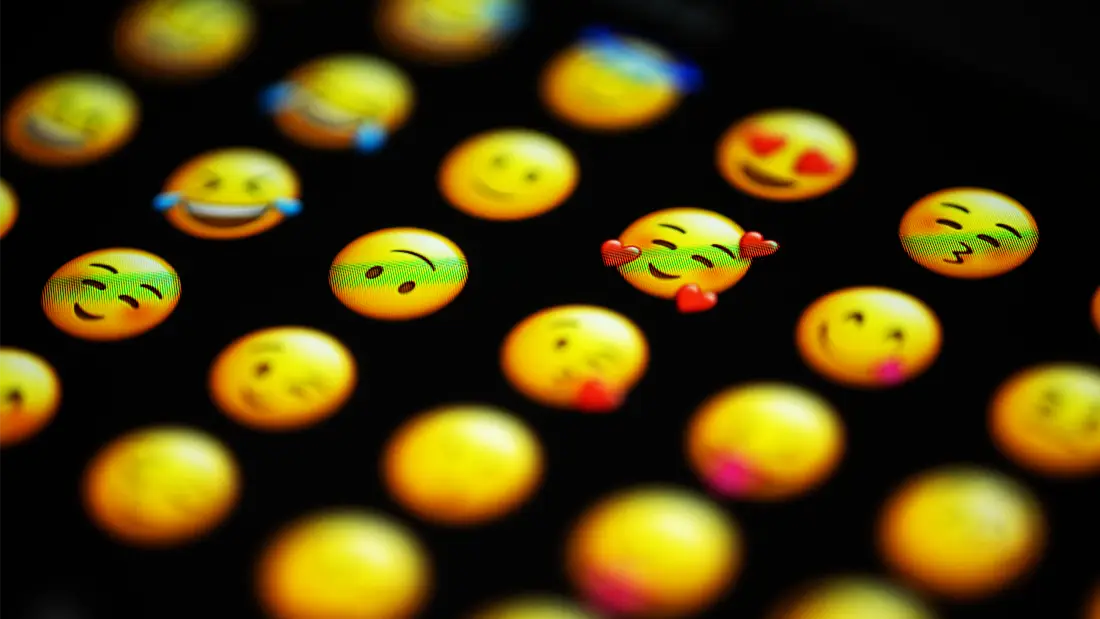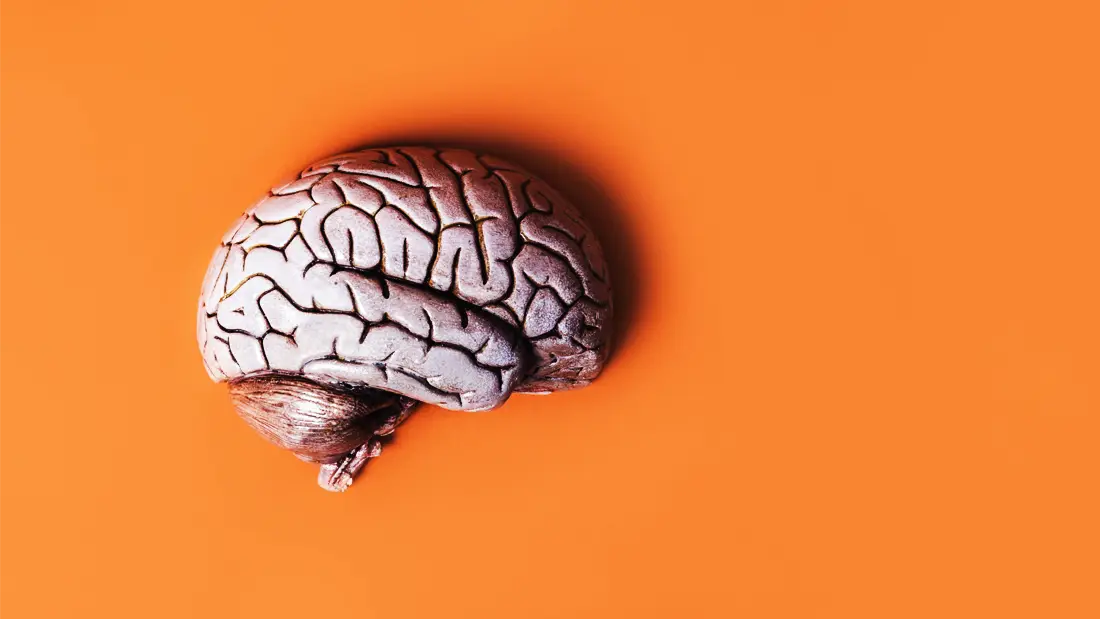Envision savoring an exquisite wine from a disposable plastic cup… The experience would be wholly undermined, wouldn't it? Your SaaS product is the wine, and emotional design is the art of curating the perfect “vessel”: an intuitive, engaging, and delightful interface that enriches the user experience and transforms each interaction into a moment of gratification. Even a remarkable product (the wine) can be cheapened by a bad container (the plastic cup). In a parallel fashion, a SaaS advertising powerful capabilities but possessing a poorly designed interface stands to irritate users, impeded usage, and reduce enjoyment. Together, we'll find the solution to evading these mistakes.
Table of contents
- What Is Emotional Design?
- What Are the Three Levels of the Emotional System?
- How Do These Levels Interact?
- Why Are These Three Levels Essential for SaaS?
- How to Integrate Emotional Design Into Your SaaS?
- The Emotions Your Users Can Experience
- Hormones: The Secret Chemistry of UX
- Conclusion: Emotional Design, a Powerful Lever for Your SaaS
What Is Emotional Design?
Emotional design is the art of touching users' hearts. It's not just about making an interface pretty or intuitive, but about evoking positive emotions that strengthen the connection between the user and the product.
Emotional design goes beyond aesthetics: it aims to make the experience intuitive, engaging, and delightful, taking into account users' emotions and expectations. A good UI/UX design acts like an elegant wine glass: it highlights the product, improves perception, and fosters a memorable experience.
As conceptualized by Don Norman, emotional design relies on a deep understanding of how human emotions work. According to him, our emotional system is structured around three interconnected levels: the visceral, the behavioral, and the reflective. Each of these levels plays a distinct role in how we perceive and interact with the world, including with digital products and interfaces.
What Are the Three Levels of the Emotional System?
The Visceral Level: Raw Emotion
The visceral level is the most primitive of the three. It represents our instinctive, almost animalistic reactions to what we see, hear, or touch. These reactions are immediate, automatic, and largely unconscious.
Concrete example
Imagine opening a SaaS application for the first time. If the interface is visually harmonious, with soothing colors and elegant typography, you'll instantly feel a positive impression. Conversely, a cluttered or aggressive interface can trigger immediate rejection.
For SaaS products:
Visceral design is essential for a first impression. It's about creating an interface that "speaks" directly to the user's emotions, without them having to think. This involves thoughtful aesthetic choices: colors, shapes, typography, but also subtle sounds and animations.
The Behavioral Level: Emotion in Action
The behavioral level concerns our actions and reactions to a situation. It's about how we interact with a product to achieve a goal. This level is guided by efficiency, simplicity, and fluidity.
Concrete example
Let's take the example of project management software. If the user manages to create a task, assign responsibilities, and track progress in just a few clicks, they'll experience immediate satisfaction. Conversely, complex steps or frequent errors will generate frustration.
For SaaS products:
Behavioral design focuses on the user experience (UX) in a practical sense. It's about making interactions intuitive, fluid, and rewarding. Well-thought-out micro-interactions, visual feedback, and frictionless navigation are essential to evoke positive emotions at this level.
The Reflective Level: Emotion in Reflection
The reflective level is the most conscious of the three. It encompasses our thoughts, memories, and judgments about a past experience. It's at this level that we analyze, learn, and form lasting opinions.
Concrete example
After using a SaaS tool for several weeks, a user might say, "This software has really saved me time and made me more efficient." This positive reflection reinforces their attachment to the product and increases the likelihood that they'll recommend it.
For SaaS products:
Reflective design aims to create memorable experiences that leave a lasting impression. This can involve moments of surprise and delight (like an unexpected animation after completing a task), but also overall consistency that builds trust and satisfaction.
How Do These Levels Interact?
These three levels don't function in silos. They're interconnected and mutually influence each other to create an overall emotional experience. For example:
- A visually appealing interface (visceral) can encourage a user to explore further (behavioral), which reinforces their overall satisfaction (reflective).
- Conversely, repeated frustration during use (behavioral) can harm the overall image of the product (reflective), even if the interface is beautiful (visceral).
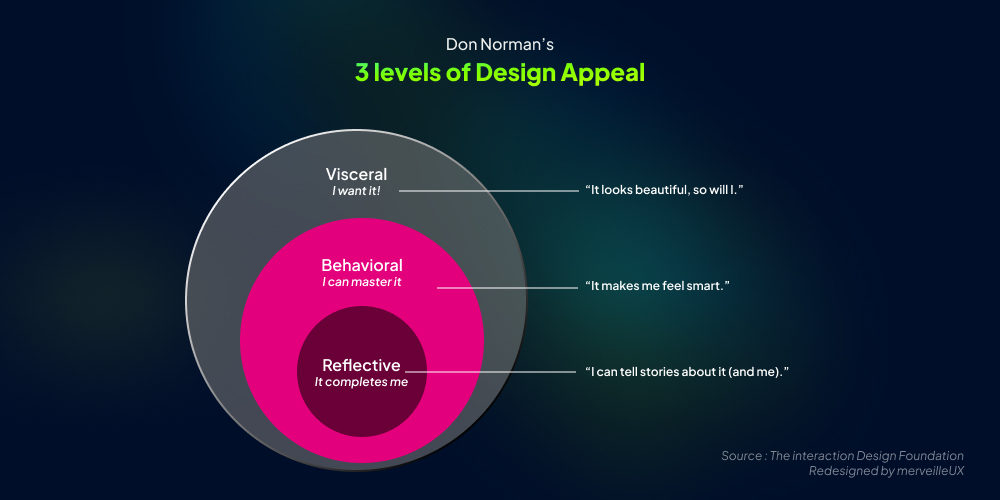
Why Are These Three Levels Essential for SaaS?
Users don't just choose a tool for its features, but also for how it makes them feel. In the world of Software as a Service (SaaS), where competition is increasingly fierce and user expectations are high, emotional design is a powerful lever for:
- Attracting: the visceral level captures attention from the first contact.
- Engaging: the behavioral level ensures a smooth and rewarding experience.
- Retaining: the reflective level transforms users into ambassadors.
By understanding and integrating these three levels, you can create SaaS products that are not only functional but also emotionally engaging.
How to Integrate Emotional Design Into Your SaaS?
- Understand your users: empathy should be at the heart of your approach. Use personas and user journeys to identify the emotions you want to evoke. To do this, don't hesitate to conduct user research.
- Play with micro-interactions: a subtle animation, a pleasant sound, or visual feedback can transform a mundane task into a moment of pleasure.
- Use gamification: integrate playful elements to boost engagement and make the experience more immersive.
- Be consistent with your Design System: a successful emotional experience relies on a harmonious visual and interactive identity. Develop your Design System properly to maximize the return on investment of your money and the time spent by your Product and Development teams.
Since emotional design aims to influence users' feelings, it's essential to understand what emotions a SaaS can generate and how they impact the experience.
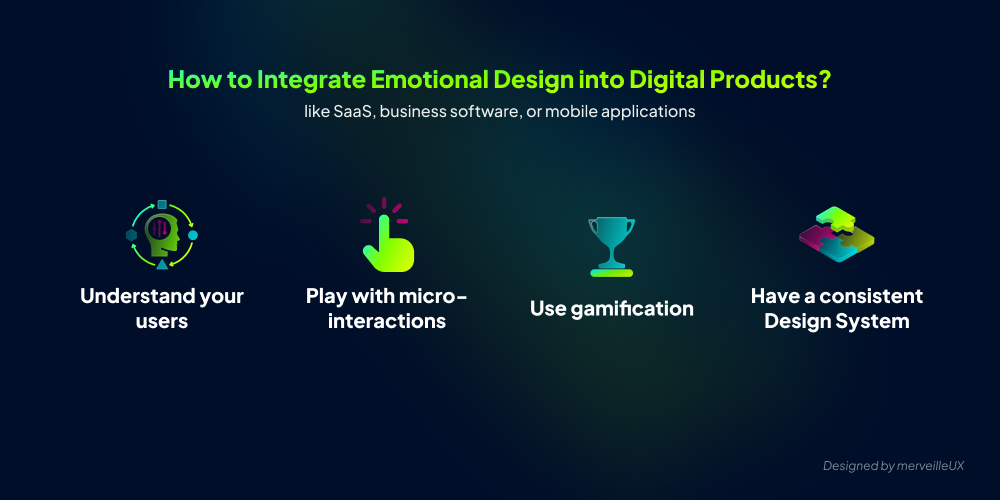
The Emotions Your Users Can Experience
When a user navigates a SaaS software or application, their feelings aren't limited to technical actions: they traverse a true spectrum of emotions, which influence their engagement and loyalty. A smooth and enjoyable experience can seduce and retain them, while a frustrating or confusing interface can drive them away.
We invite you to browse a non-exhaustive list of emotions that a user can experience. Ask yourself this question for each emotion: "Does my software elicit this feeling in my users?"
Positive Emotions of Users
- Satisfaction: the user achieves their goal easily and efficiently. The software meets their needs and expectations.
- Joy/pleasure: using the software is pleasant, intuitive, and provides a feeling of ease.
- Trust/security: the user feels confident with the software, they know they can rely on it and that their data is secure.
- Interest/curiosity: the software offers new and stimulating features that encourage exploration and learning.
- Pride/accomplishment: the user feels proud when they master the software and achieve goals thanks to it.
- Excitement/enthusiasm: new features, innovative design, or anticipation of positive results can spark excitement.
Negative Emotions of Users
- Frustration: difficulties in use, bugs, lack of information, slow software...
- Anger/aggression: recurring technical problems, data loss, ineffective customer support...
- Confusion/discouragement: complex interface, lack of clarity in instructions, features difficult to understand...
- Anxiety/stress: fear of making mistakes, fear of losing data, pressure related to using the software...
- Boredom/disinterest: unengaging software, redundant features, lack of novelty...
- Disappointment/betrayal: the software doesn't keep its promises, missing features, disappointing customer support...
Neutral (But Influential) Emotions of Users
Some emotions are less clear-cut but can influence the user experience, for better or worse:
- Surprise: a new feature or unexpected update can be perceived positively... or disorient the user.
- Curiosity: discovering a new tool or an intriguing option can motivate exploration. However, if the interface doesn't guide the user well, this curiosity can quickly turn into confusion.
Hormones: The Secret Chemistry of UX
We often talk about user experience, but did you know that your customers' satisfaction is also a matter of chemistry? Behind every click, every interaction with your SaaS, are hormonal reactions that directly influence engagement, loyalty, and, ultimately, your revenue. Keep in mind that you should keep designing ethically when influencing users' emotions.
Hormones like dopamine (reward), adrenaline (excitement), oxytocin (attachment), cortisol (stress), and serotonin (happiness) play a key role in how your users perceive your product.
The goal of emotional design is to create a user experience that promotes the release of "positive" hormones (dopamine, oxytocin, serotonin) and minimizes the production of cortisol, the stress hormone.
To learn more about the 5 hormones to stimulate in your SaaS and how to do it concretely, check out our dedicated article.
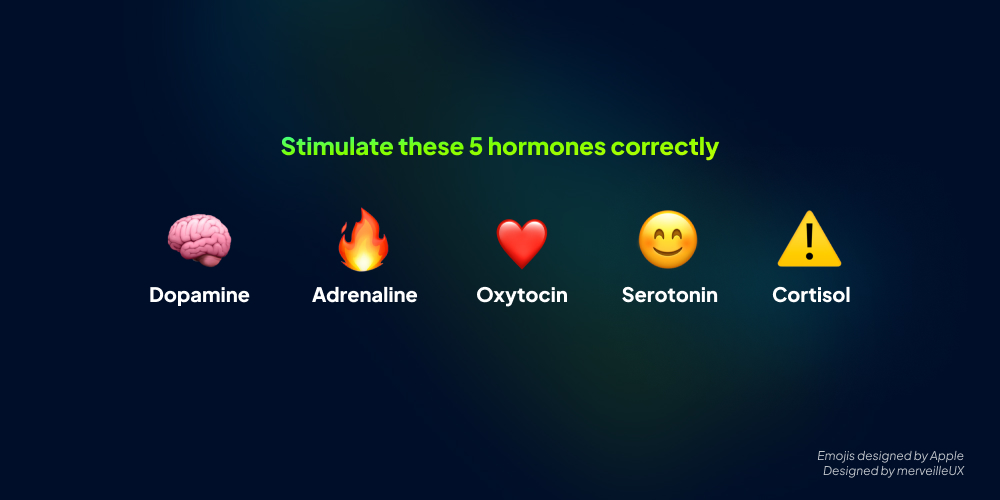
Conclusion: Emotional Design, a Powerful Lever for Your SaaS
Emotional design isn't limited to aesthetics: it's the true driver of the user experience. By understanding and influencing your users' emotions through the three emotional levels (visceral, behavioral, and reflective), you can transform a simple interaction into a memorable and engaging experience.
In a SaaS world where competition is fierce, features alone are no longer enough. What makes the difference is how your product makes your users feel. A well-thought-out design can spark curiosity, ignite enthusiasm, and build lasting customer loyalty.
- An attractive design captures attention (visceral level).
- A smooth experience encourages engagement (behavioral level).
- A feeling of accomplishment and confidence promotes loyalty (reflective level).
By applying these principles and stimulating the right emotions, you create a strong connection with your users.
